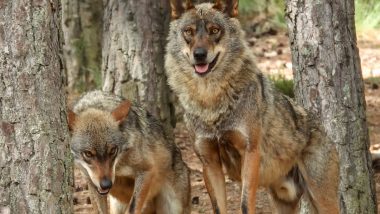Bahraich, September 9: In a bid to combat the persisting wolf threat in Uttar Pradesh's Bahraich district, the forest department called Dr. Shaheer Khan, a wildlife expert from Wildlife Institute of India Dehradun, with an experience of 8 years in search and rescue of wolves. Speaking with ANI, Dr Khan said that wolves are social animals, and generally they are in packs of 4, 6, or 8, and they have an alpha pair (parent) who acts as the leader of the pack, and in this case it's a pack of 6. We are trying our best to rescue them. I am also giving my expertise to the forest team to learn their behaviour, ecology, biology, and many times their pugmarks, as they are very similar to jackals.
When asked about how and why the wolves become "man-eaters," Dr Khan said that there are chances that the wolf got confused between a human child and animals like deer, and thus they attacked. "In the case of wolves, the term is not man-eater, but child-lifter, and such cases happened after a gap of 20-25 years. The last case of human-wolf conflict was in 2004, and before that, it happened in 1994. In the case of the Bahraich wolf menace, I observed the problem of open defection, and maybe some wolf got confused and thought the human child was a four-legged animal like deer, and they attacked," he said. Wolf Scare in Bahraich: Canines Still at Large, Authorities Ramp Up Efforts To Capture Remaining Predators in Uttar Pradesh.
"Human children become easy prey for them, but the good thing is that they haven't attacked any humans in the past 7-8 days, which means the wolves have not fully turned into man-eaters and may have returned back to their natural habitat as the flood situation also got normal here, and if no wolf attack happens in the coming days, then it would be a sigh of relief for us because that would mean that he returned back," Khan added. Answering about the reason why wolves are called keystone species and what their importance is in the ecosystem, Khan said, "Keystone means the base of the stone on which the whole structure depends, and it's the most important stone; that's why it is called keystone. And wolf is the keystone of grassland, and if you remove the wolf, then the whole ecosystem will get disturbed."
Dr Khan said that there's a study on wolves at Yellowstone National Park (YNP), which is called trophic cascades, in which it's mentioned that people killed populations of wolves in a particular area to save their sheep from wolf attacks. This led to the increase in the population of deer after 5-10 years, which disturbed the whole vegetation, and even the deer ate growing saplings, which caused soil erosion. "Due to this, the area became flood-prone, and after some years, wolves were reintroduced in that particular area, which balanced the population of deer, and due to the fear of wolves, deer stopped going near the rivers, which helped the trees grow, and stopped the soil erosion, and the whole ecosystem of that particular area got restored," he added. Wolf Attacks Continue in Bahraich: Death Toll Touches 8 As 3-Year-Old Child Killed, Woman Injured After Being Attacked by Wolves in Uttar Pradesh.
Meanwhile, Forest General Manager Sanjay Pathak has voiced his disapproval over false reports and rumours concerning the recent wolf attacks. Pathak criticised certain media outlets for misidentifying jackals as wolves and said, "Many media persons are running news without confirmation and calling jackals as wolves." Pathak added that such misinformation disrupts operations and confuses the team. Despite installing snap cameras using thermal technology to track wolves, no wolves have been detected so far. Pathak explained that the normalising river water levels and dried-up banks might have led the wolves to return to their natural habitat, which could explain the absence of wolf attacks in the past 6 to 7 days.
He warned that while they are currently issuing warnings to those spreading rumours, further action may be needed. "If such rumours don't stop, we are considering asking the district administration and police to take necessary action," Pathak added. So far four wolves have been caught. Drone visuals taken on Saturday morning at Harbaksh Purwa village showed a vast stretch of agricultural land under surveillance. On Saturday morning, 2-3 kilometres away from Harbaksh Purwa, forest officials conducted a search operation to capture the wolf as it was located here on Friday night with the help of thermal drones.













 Quickly
Quickly














 GT
GT







